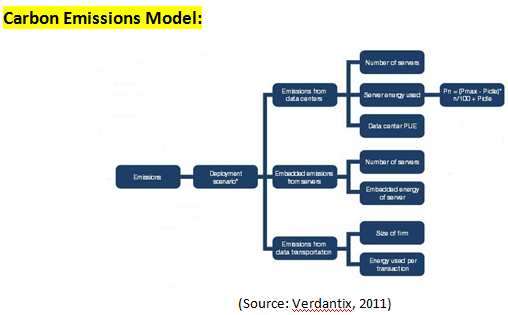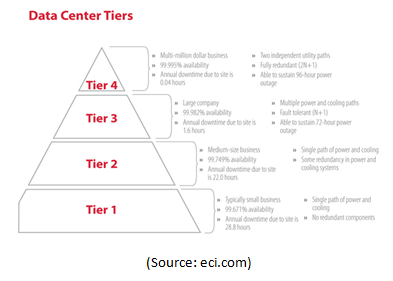GREEN IT: WHY IMPORTANT ?
Datacenter tiers – Tier I to IV – represent a standardized method to define the uptime of a datacenter. The tiers are useful in measuring: (1) datacenter performance, (2) investment, and (3) Return on Investment (ROI). The four tiers: (1) tier 1: composed of a single path for power and cooling distribution, without redundant components, providing 99.671% availability. This is the simplest and typically used by small businesses, (2) tier II: composed of a single path for power and cooling distribution, with redundant components, providing 99.741% availability, (3) tier III: composed of multiple active power and cooling distribution paths, but only one path active, has redundant components, and is concurrently maintainable, providing 99.982% availability, and (4) tier IV: composed of multiple active power and cooling distribution paths, has redundant components, and is fault tolerant, providing 99.995% availability (eci.com).
Kind of upfront costs when building datacenter: (1) upfront planning, design and commissioning, (2) base building shell and property, (3) fire suppression and detection, (4) building permits and local taxes, (5) datacenter infrastructure, (6) network connection cost, (7) power, (8) datacenter staffing, (9) annual facility and infrastructure maintenance (onlinetech.com). Building datacenter mainly control: (1) complete control over an operating environment, including access, temperature, etc, (2) low risk of losing leasing, and (3) ability to leverage and share existing space (onlinetech.com).
Datacenters have traditionally relied on fossil fuels as their primary energy source. Fossil fuel prices continue to rise and nuclear power presents numerous concerns regarding sustainability and safety. While coal-burning plants have been around for even longer than datacenters, the environmental consequences haven’t changed. Smog, soot, acid rain, toxic air emissions, and even global warming, are caused, in part, by burning coal. Ash, sludge, toxic chemicals, and waste heat can also be attributed to the nearly 8 tons of coal consumed worldwide each year, according to Think Global Green (Rhodes, ospmag.com).
Energy used by datacenters is predicted to rise – IT research firm IDC predicts a 50-fold increase from 2011 to 2020. As the volume of business data grows exponentially, more facilities will be built to house and manage this data, which in turn will increase electricity demand. According to a report last year by the U.K.-based DatacenterDynamics, datacenters already accounted for between 1.1% and 1.5% of the world’s total energy consumption in 2010 and in 2012 – will consume almost 20% more energy than last year (bell.ca, 2012).
Feeding energy-hungry datacenters has become an unavoidable necessity of doing business, but forward-thinking organizations are taking action to reduce the long-term cost and environmental impacts. Highly advanced datacenters provide organizations with ways to simultaneously mitigate the rising costs of energy and reduce environmental footprint.



